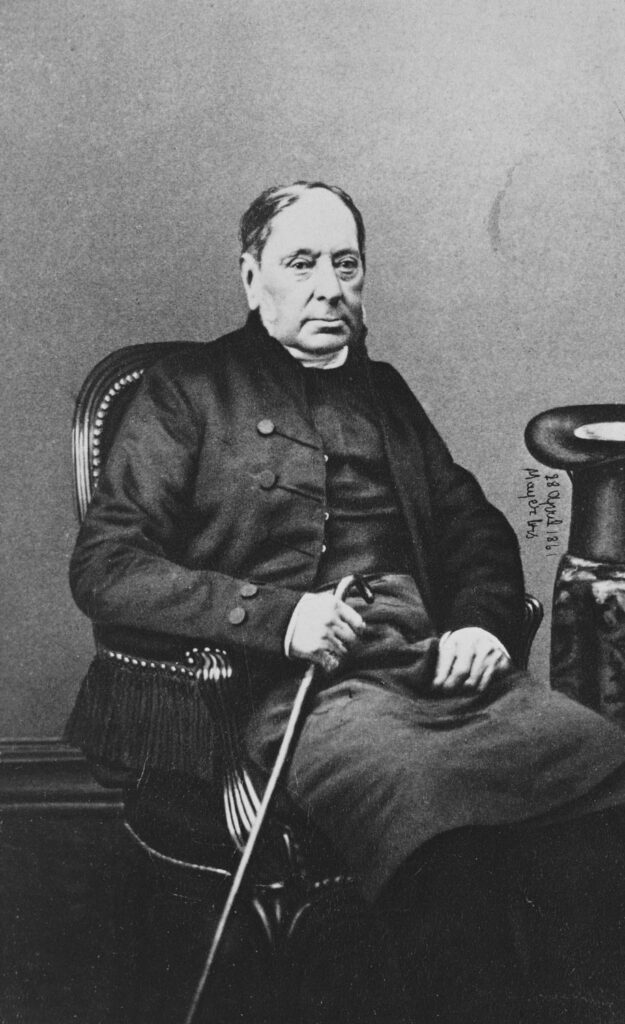The Right Reverend George Davys, Bishop of Peterborough
2 August 2020
‘”1780, November 2. George Son of John Davies Gent. and Sophia his Wife was Born October ye 1st. 1780 and Baptized this Day.- Bap : 2.” This was Dr. Davys, late Bishop of Peterborough, and formerly Preceptor to Her Majesty Queen Victoria. He was born at the old Manor House, opposite the Church gates.’
So states Loughborough’s Parish Register, as referenced in ‘Chapters in the History of Loughborough,’ published in 1883 by W G Dimock Fletcher. John Davys, ‘gent,’ hailed from Remptstone, Notts, whilst his wife Sophia was the daughter of the Revd B Wigley of Sawley in Derbyshire. Young George was born in Loughborough’s old Manor House, now Caravelli’s Restaurant.
A graduate of Christ’s College Cambridge, where he received financial assistance to enable him to study, Rev Davys was a curate in Essex and Cambridgeshire before being given his own parish at Willoughby on the Wolds. He held this post (presumably leaving it to be run in his absence by a curate) until 1829, at which time he was granted the living of Allhallows-on-the-Wall, London, by the king. In addition, he was appointed Dean of Chester on 10 January 1831.
Revd George Davys became preceptor (a role seen as part tutor, part mentor) to the Princess Victoria in April 1823, shortly before her fourth birthday. It was a task he would share with her German governess, Baroness Lehzen, visiting Kensington Palace regularly to teach Victoria the basic skills of literacy and numeracy and give religious instruction – a subject dominated in education at that time by the writings of the evangelical moralist Sarah Trimmer.
As she grew older Davys also taught Victoria Greek, Latin, mathematics and literature. Despite the future she was facing as Britain’s Queen, Victoria wasn’t given the classical education experienced by boys of her class at that time, but even so she spent five hours a day, six days a week in formal lessons. Other subjects she studied included painting and drawing, dancing, music and singing, history, French, Italian and German.
Whilst English was always spoken in Kensington Palace, Revd Davys is said to have commented on the princess’s German accent and – an exceedingly good elocutionist himself – to have helped her to get rid of it.
Victoria is said to have been a ‘spoiled, self-willed little exhibitionist’ who was ‘out of her mother’s control’. However, the ‘reverend tutor’ was said to have ‘a quiet humour’ and enjoyed his pupil’s ‘clever repartees.’ She in turn, is said to have ‘constantly spoken of him as ‘my kind, good master.’ In correspondence in later years, however, Victoria is said to have described Revd Davys as ‘monotonous and soporific.’
A memorial work about ‘The beautiful life and illustrious reign of Queen Victoria’ published in the year of her death states that the Duchess of Kent thought very highly of her daughter’s tutor, who also served as domestic chaplain at Kensington Palace. ‘I like your sermons so much, Mr Dean,’ she is once said to have stated, adding as he bowed low, ‘because they are so short.’
Both Baroness Lehzen and Revd Davys claimed to have been the one who told Victoria she was next in line to the throne. In an often-told story, Baroness Lehzen is said to have placed a genealogical table into the twelve-year-old princess’ history book for her to find, on which Victoria is said to have commented, ‘I am nearer the throne than I thought.’
However, Revd Davys’ son, Canon Edmund Davys, claimed it was his father who informed the young princess, telling the following story:
‘My father had set her to make a chart of the kings and queens. She got as far as ‘Uncle William.’ Next day my father said to the princess, “But you have not put down the next heir to the throne.” She rather hesitated, and said, “I hardly like to put down myself.” My father mentioned the matter to the Duchess of Kent, who said she was so glad that the truth had come upon her daughter in this way, as it was time she became aware what responsibility was awaiting her.’
Victoria became queen in 1837 on the death of her uncle, William IV. She was eighteen. Revd Davys was appointed Bishop of Peterborough a short time afterwards in May 1839, a year before boundary changes saw Loughborough come under the Diocese of Peterborough.
An ‘old boy’ of Loughborough Grammar School from the time when it stood in the churchyard of All Saints church, Davys laid the foundation stone of the school’s new buildings at Burton Walks on Friday 9 August 1850. The event included a grand procession preceded by a military band from All Saints Parish Church to the new school grounds.
The Right Reverend George Davys died of bronchitis at the Bishop’s Palace, Peterborough, on 18 April 1864 and was buried in the graveyard of Peterborough Cathedral. Queen Victoria sent a royal carriage and liveried servants as her representatives to his funeral and in Loughborough, the minute bells of All Saints and Emmanuel churches tolled for the entire day.
There is a memorial east window in Loughborough’s All Saints’ Parish Church in Davys’ memory, as well as a plaque.

Revd George Davys
Photo source – Royal Collection Trust
https://www.rct.uk/collection/2907067/dr-davys-bishop-of-peterborough-1780-1864
Compiled by Alison Mott
References:
‘The Beautiful Life and Illustrious Reign of Queen Victoria. Chapter 1: In The Days of Infancy,’ by the Rev John Rusk, PhD, A Memorial Volume, 1901.
Wikipedia entry on George Davys (See here.)
The Oxford Dictionary of National Biography: Victoria (1819–1901), by H. C. G. Matthew and K. D. Reynolds (online version published May 2012)
‘The Houses, Past and Present, of Loughborough Grammar School,’ by Roger Willson.